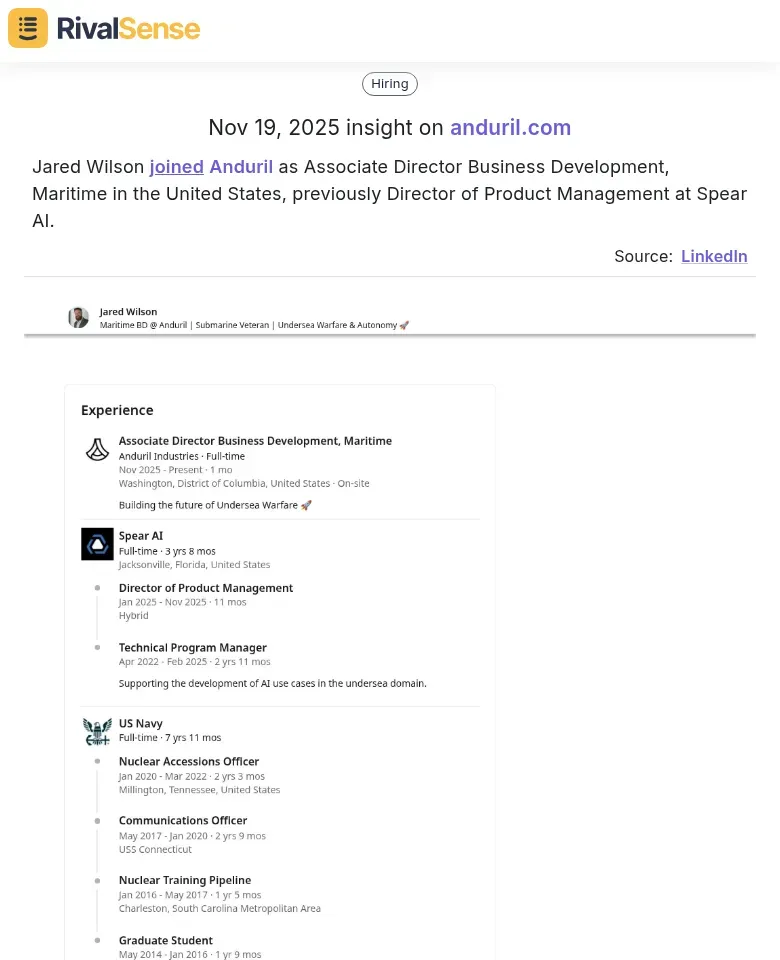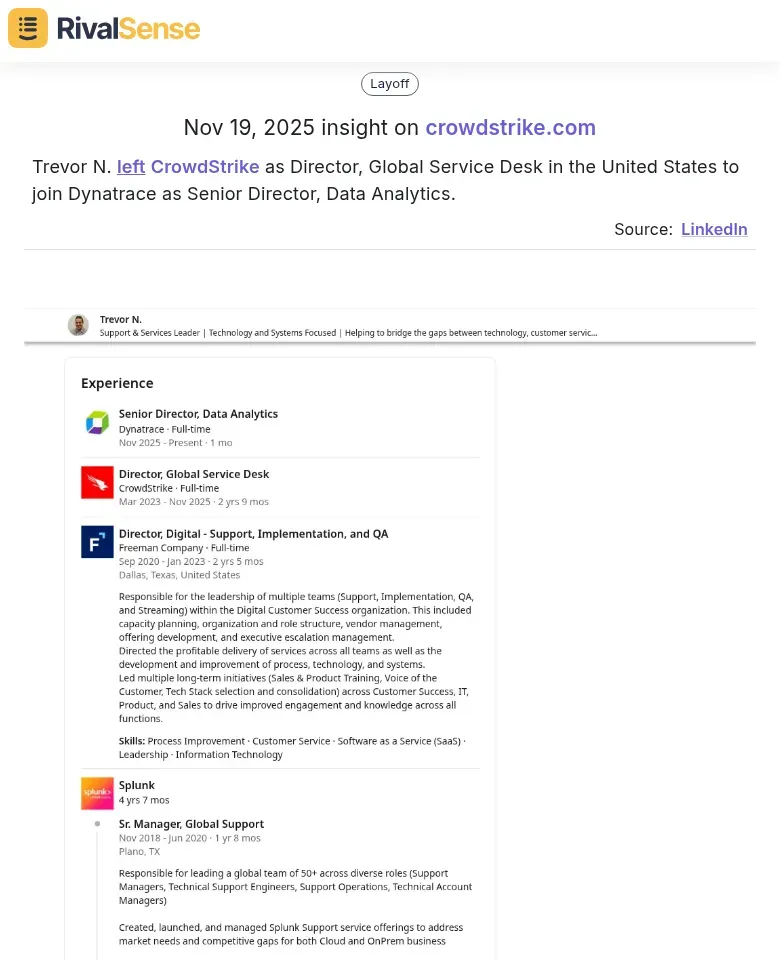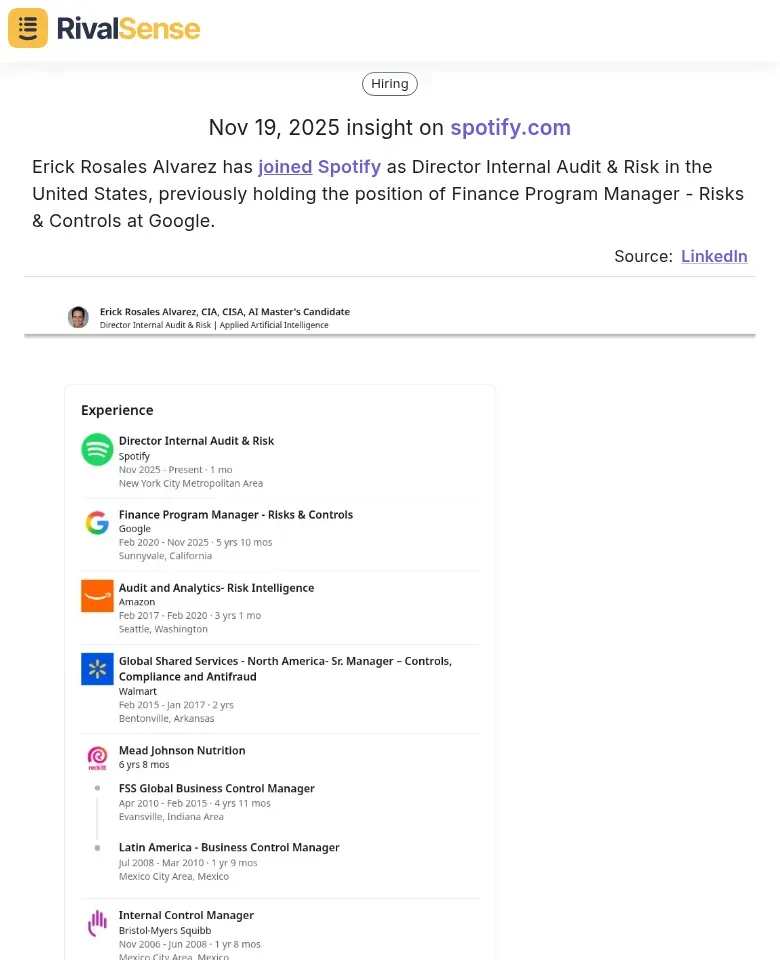Beginner's Guide: Track Competitor Hiring & Layoffs for Key Account Wins
Tracking competitor hiring and layoffs provides invaluable strategic intelligence that goes beyond simple headcount changes. When competitors ramp up hiring in specific departments like enterprise sales or product development, they're signaling strategic priorities and expansion plans. Personnel movements reveal competitor strategy shifts in real-time, allowing you to anticipate market changes and position for key account wins before your competitors can react.
Practical steps to get started:
- 📈 Monitor LinkedIn for competitor job postings and employee departures
- 🔔 Set up Google Alerts for competitor layoff announcements
- 🎯 Track hiring patterns across departments to identify strategic focus areas
- 💡 Identify laid-off employees who may bring valuable customer insights
Early detection of these trends gives you a competitive advantage in anticipating market shifts and positioning for key account wins.
Key Insights from Competitor Hiring Patterns
Tracking competitor hiring patterns reveals strategic shifts before they become public. By analyzing the roles and departments where competitors are investing, you can anticipate their next moves and prepare your response. For instance, if a rival suddenly hires multiple AI engineers, they're likely investing in AI-driven products, giving you a heads-up to adjust your own strategy.
Example from RivalSense:
Jared Wilson joined Anduril as Associate Director Business Development, Maritime in the United States, previously Director of Product Management at Spear AI.

This insight is valuable because it shows how tracking new hires in business development roles can indicate a competitor's expansion into specific markets or segments, like maritime in this case, allowing you to monitor their strategic priorities and adapt your approach.
Practical steps:
- ✅ Monitor job boards and LinkedIn for competitor postings
- ✅ Categorize hires by department and seniority
- ✅ Note geographic concentrations of new roles
- ✅ Track layoffs in declining business units
- ✅ Set alerts for sudden hiring spikes
Regular analysis of hiring trends provides early warning of strategic moves, enabling timely counter-strategies.
Learning from Competitor Layoffs and Departures
When competitors announce layoffs or key departures, it's a goldmine for strategic intelligence. These personnel changes often reveal underlying issues or shifts in strategy that you can leverage. For example, mass layoffs in a sales department might indicate cost-cutting or a market exit, creating opportunities for you to target their vulnerable accounts.
Example from RivalSense:
Trevor N. left CrowdStrike as Director, Global Service Desk in the United States to join Dynatrace as Senior Director, Data Analytics.

This departure is valuable to track because it highlights talent flow between competitors and may signal operational changes or new focus areas, such as data analytics at Dynatrace, which could impact your competitive landscape and reveal weaknesses to exploit.
Practical Checklist:
- 🔍 Set up alerts for competitor layoff news
- 🔍 Track key employee departures on LinkedIn
- 🔍 Monitor competitor job postings for role changes
- 🔍 Create a talent acquisition pipeline from departing competitors
- 🔍 Analyze which departments are most affected by cuts
Remember: Competitor weakness is your opportunity. Systematic tracking uncovers strategic vulnerabilities you can exploit.
Practical Steps to Track and Analyze Competitor Movements
To effectively track competitor hiring and layoffs, you need a systematic approach. Leveraging tools and multiple data sources ensures you don't miss critical changes that could impact your business strategy. By correlating personnel data with financial performance, you can gain deeper insights into competitor intentions and market dynamics.
Example from RivalSense:
Erick Rosales Alvarez has joined Spotify as Director Internal Audit & Risk in the United States, previously holding the position of Finance Program Manager - Risks & Controls at Google.

Monitoring such management changes is crucial because it can reveal a competitor's focus on risk management and internal controls, indicating potential shifts in stability or compliance strategies that might affect partnerships or competitive positioning.
Practical steps:
- 📊 Create a competitor tracking spreadsheet with key contacts and roles
- 📊 Set weekly review sessions to analyze new data
- 📊 Cross-reference hiring patterns with customer reviews and product launches
- 📊 Monitor Glassdoor reviews for insights into company culture changes
- 📊 Track competitor job descriptions for clues about new strategic directions
Using a combination of these methods helps you build a comprehensive view of competitor movements.
Case Studies: Turning Insights into Actionable Strategies
Real-world examples demonstrate how tracking competitor movements leads to actionable strategies. By learning from others' experiences, you can apply similar tactics in your business to drive growth and secure key accounts. For instance, when a competitor downsizes, it often creates openings for you to step in and capture market share.
When a major competitor announced layoffs in their enterprise sales division, one SaaS company used RivalSense to identify vulnerable accounts. They developed targeted account plans focusing on the competitor's top 20 enterprise clients, creating personalized outreach highlighting their platform's stability and dedicated support. The sales team received specific talking points addressing the competitor's reduced service capacity, while marketing launched a 'Stability Matters' campaign targeting those exact accounts. Within three months, they secured 8 new enterprise deals worth $2.4M in ARR.
Actionable steps:
- Monitor competitor job boards and LinkedIn for hiring/layoff patterns weekly
- Create a 'vulnerable accounts' list within 48 hours of competitor announcements
- Develop tailored messaging addressing the specific gaps created by competitor moves
- Align sales outreach with marketing campaigns for consistent messaging
- Track conversion rates on targeted accounts to measure strategy effectiveness
💡 Tip: Use layoff announcements as triggers to accelerate your sales cycle with prospects who may be concerned about their current vendor's stability.
Conclusion: Building a Competitive Edge with Continuous Monitoring
Building a competitive edge requires integrating competitor hiring and layoff tracking into your regular business intelligence processes. Continuous monitoring allows you to stay ahead of market shifts and capitalize on opportunities as they arise. By fostering a culture of proactive awareness, your team can quickly respond to competitor changes and turn them into advantages.
Practical steps:
- 🚀 Create a competitor tracking dashboard
- 🚀 Assign a team member to lead monitoring efforts
- 🚀 Hold monthly strategy sessions to adapt based on findings
- 🚀 Measure impact by linking insights to revenue growth and market share
To help you get started with effective competitor tracking, try out RivalSense for free at https://rivalsense.co/ and get your first competitor report today! This tool tracks product launches, pricing updates, event participations, partnerships, regulatory aspects, management changes, and media mentions, delivering all insights in a weekly email report to keep you informed and ahead of the competition.
📚 Read more
👉 Leveraging Competitor Management Changes for Strategic Advantage
👉 The Ultimate Guide to Key Account Tracking in Salesforce
👉 Essential Competitor Analysis Strategies for Investment & Wealth Management
👉 How RivalSense Helps Counter Talent Loss: A føtex Case Study
